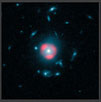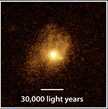2023 | 2022 | 2021 | 2020 | 2019 | 2018 | 2017 | 2016 | 2015 | 2014 | 2013 | 2012 | 2011 | 2010 | 2009 | 2008 | 2007
News 2013
New tool may unveil inhabitable worlds
(2013-11-04)
 SPIRou, a near-infrared spectropolarimeter, will also investigate the birth of Sun-like stars and their planets SPIRou, a near-infrared spectropolarimeter, will also investigate the birth of Sun-like stars and their planets |
Première observation de la distribution d’hydrogène neutre d’une galaxie avec le radio télescope KAT-7, en Afrique du sud
(2013-07-12)
Discovery of the candidate most massive star
(2013-04-26)
McGill Researchers from the CRAQ use ALMA to rewrite the history of Universe's stellar baby boom
(2013-04-23)
Une galaxie « éco-certifiée » découverte par des chercheurs de McGill et du CRAQ
(2013-04-23)
Astrophysicist Paul Charbonneau writes a book on "Solar and Stellar Dynamos"
(2013-04-12)
The nature and technology university research centres occupy a significant place in the world
(2013-04-02)
CHIME Telescope project aims to shed new light on evolution of universe
(2013-01-23)
 Astrophysicists from the McGill and the CRAQ will participate, with other Canadian astronomers, in the understanding of the mysteries of ‘dark energy’. Astrophysicists from the McGill and the CRAQ will participate, with other Canadian astronomers, in the understanding of the mysteries of ‘dark energy’. |
This web site is for Microsoft Internet Explorer and Firefox.

 Une équipe d'astronomes dirigée par Claude Carignan, professeur émérite au Département de physique de l'Université de Montréal, membre du CRAQ et détenteur d'une chaire de recherche à l'Université de Cape Town, a réalisé la première observation de la distribution d'hydrogène neutre (HI) d’une galaxie à l'aide du radiotélescope KAT-7, précurseur de ce qui deviendra le plus grand radio télescope au monde, le Square Kilometer Array (SKA).
Une équipe d'astronomes dirigée par Claude Carignan, professeur émérite au Département de physique de l'Université de Montréal, membre du CRAQ et détenteur d'une chaire de recherche à l'Université de Cape Town, a réalisé la première observation de la distribution d'hydrogène neutre (HI) d’une galaxie à l'aide du radiotélescope KAT-7, précurseur de ce qui deviendra le plus grand radio télescope au monde, le Square Kilometer Array (SKA).  An international research team, that includes Anthony Moffat, Professor Emeritus at the physics department of the Université de Montréal and member of the CRAQ, observed a binary star which birth mass was of the order of 300 to 400 times the mass of our Sun. The current total mass of the binary system composed of two stars is estimated to be about 200-300 times the mass of the Sun, according to massive stars evolution models. The unexpected mass makes this duo the most massive binary star system known to date.
An international research team, that includes Anthony Moffat, Professor Emeritus at the physics department of the Université de Montréal and member of the CRAQ, observed a binary star which birth mass was of the order of 300 to 400 times the mass of our Sun. The current total mass of the binary system composed of two stars is estimated to be about 200-300 times the mass of the Sun, according to massive stars evolution models. The unexpected mass makes this duo the most massive binary star system known to date. Observations with the Atacama Large Millimeter/submillimeter Array (ALMA) show that the most vigorous bursts of star birth in the cosmos took place much earlier than previously thought. The results are published in a set of papers to appear in the journal Nature and in the Astrophysical Journal. The research is the most recent example of the discoveries coming from the new international ALMA observatory, which celebrates its inauguration in March 2013.
Observations with the Atacama Large Millimeter/submillimeter Array (ALMA) show that the most vigorous bursts of star birth in the cosmos took place much earlier than previously thought. The results are published in a set of papers to appear in the journal Nature and in the Astrophysical Journal. The research is the most recent example of the discoveries coming from the new international ALMA observatory, which celebrates its inauguration in March 2013. C’est grâce aux données des télescopes spatiaux WISE et Hubble de la NASA, et de l’interféromètre et radiotélescope IRAM en France qu’une équipe de chercheurs internationale dirigée par James Geach, stagiaire postdoctoral à l’Université McGill et au CRAQ, a réussi à identifier ce qui pourrait être la galaxie la plus « verte » jamais vue. Il s’agirait d’une galaxie capable de transformer sa réserve de gaz pour former des étoiles avec un taux d’efficacité avoisinant les 100%. Les résultats sont publiés dans un article dans l'édition du début du mois avril 2013 de la revue Astrophysical Journal Letters.
C’est grâce aux données des télescopes spatiaux WISE et Hubble de la NASA, et de l’interféromètre et radiotélescope IRAM en France qu’une équipe de chercheurs internationale dirigée par James Geach, stagiaire postdoctoral à l’Université McGill et au CRAQ, a réussi à identifier ce qui pourrait être la galaxie la plus « verte » jamais vue. Il s’agirait d’une galaxie capable de transformer sa réserve de gaz pour former des étoiles avec un taux d’efficacité avoisinant les 100%. Les résultats sont publiés dans un article dans l'édition du début du mois avril 2013 de la revue Astrophysical Journal Letters.  Paul Charbonneau, professor at the physics department of the Université de Montréal and member of the Centre de Recherche en Astrophysique du Québec, writes a manual on the theories of Solar and stellar dynamos. This book has an informative approach on the principle of dynamos in astrophysics, which are essential for the understanding of cosmic magnetic fields at all scales, from planet to stars, up to entire galaxies.
Paul Charbonneau, professor at the physics department of the Université de Montréal and member of the Centre de Recherche en Astrophysique du Québec, writes a manual on the theories of Solar and stellar dynamos. This book has an informative approach on the principle of dynamos in astrophysics, which are essential for the understanding of cosmic magnetic fields at all scales, from planet to stars, up to entire galaxies. The nature and technology university research centres are participating in the progress of scientific knowledge, the development of local expertise, and in the attraction of international experts in all fields of natural science and engineering.
The nature and technology university research centres are participating in the progress of scientific knowledge, the development of local expertise, and in the attraction of international experts in all fields of natural science and engineering.